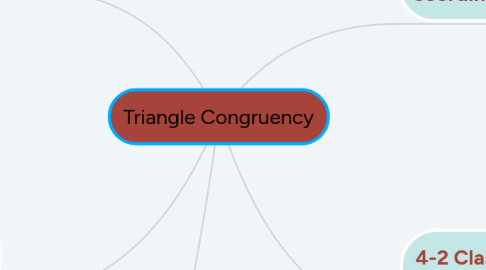Triangle Congruency
by Angelica Hernandez


1. 4-3 Finding the measures of interior and exterior angles.
1.1. Auxiliary Line: A line that is added to a figure aid in a proof.
1.2. Corollary: A theorem whose proof follows directly from another theorem.
1.3. Interior: The set of all points inside the figure. Exterior: The set of all points outside the figure.
1.3.1. Interior Angle: Formed by 2 sides of a triangle.
1.3.2. Exterior Angle: Formed by 1 side of the triangle and extension of an adjacent side.
1.4. A remote interior angle is not adjacent to the exterior angle.
2. 4-4 Using properties of congruent angles.
2.1. Corresponding angles and sides of congruent triangles are polygons with an equal number of sides.
2.2. A helpful hint is that 2 vertices that are the endpoints of a side are called consecutive vertices.
2.3. To name all congruent corresponding parts you have to identify all pairs of corresponding congruent parts.
3. 4-5 Applying SSS & SAS to construct triangles ad solve problems.
3.1. Triangles rigidy gives you a shortcut for proving 2 triangles congruent.
3.1.1. Something to remember is that adjacent triangles share a side, so you can apply the Reflexive Property to get a pair of congruent parts.
3.2. An included triangle is an angle formed by 2 adjacent sides of a polygon.
4. 4-1 Drawing, Identifying and Describing the transformations in the coordinate plane.
4.1. Something to keep in mind with reflections is that repeated reflections can create any reflections of any section over a line through the left or right side of the section.
4.2. Isometry is a transformation that preserves length, angle measure and area.
4.2.1. Another name for isometry is rigid transformation.
5. 4-2 Classifying triangles by their angle measures and side lengths.
5.1. You classify angles 2 ways.
5.1.1. Angles: Acute, Right, Obtuse, Equilanguar.
5.1.1.1. Obtuse Angle: One obtuse angle.
5.1.1.2. Right Triangle: One right angle.
5.1.1.3. Acute Angles: Has 3 acute sides,
5.1.2. Sides: Equilateral, Isosceles , Scalene.
5.1.2.1. Isosceles Triangle: At least 2 congruent sides.
5.1.2.2. Equiangular Triangle: 3 congruent sides.
5.1.2.3. Scalene Triangle: No congruent sides.

